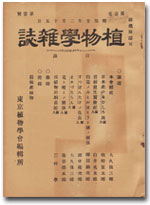All issues

Volume 59 (1946)
- Issue 697-702 Pages 7・・・
- Issue 695-696 Pages 3・・・
- Issue 693-694 Pages 1・・・
- Issue 691-692 Pages 1・・・
Volume 59, Issue 697-702
Displaying 1-8 of 8 articles from this issue
- |<
- <
- 1
- >
- >|
-
1946 Volume 59 Issue 697-702 Pages Cover_697-
Published: 1946
Released on J-STAGE: October 21, 2023
JOURNAL FREE ACCESSDownload PDF (131K) -
Arika Kimura1946 Volume 59 Issue 697-702 Pages 79-90
Published: 1946
Released on J-STAGE: June 18, 2007
JOURNAL FREE ACCESS -
Toyohiko Kawatani1946 Volume 59 Issue 697-702 Pages 90-91
Published: 1946
Released on J-STAGE: June 18, 2007
JOURNAL FREE ACCESS -
Tsugio Handa1946 Volume 59 Issue 697-702 Pages 92-95
Published: 1946
Released on J-STAGE: June 18, 2007
JOURNAL FREE ACCESS1) An anomalous structure other than“successive rings of wood and bast”was found in the tap roots of Cycas Rumphi Miq. f. undulata Kanehira. This anomaly. as seen in the transition region, is represented by two sets of bundles enclosed within a common vascular ring (Fig. 3, 1′): but the structure in question passes on gradually, in upward and downward directions, to the normal structure in the way indicated in Fig. 3.
2) Leaf-traces for a leaf vary much in number in early formed leaves, but the leaves formed later are provided constantly with two leaf-traces.View full abstractDownload PDF (502K) -
Yosinori Sugihara1946 Volume 59 Issue 697-702 Pages 96-98
Published: 1946
Released on J-STAGE: June 18, 2007
JOURNAL FREE ACCESSThe formation of proembryo in Taxus Wallichidana, Zuccarini is described. The wall-formation of the proembryo takes place after the fourth nuclear division. Sixteen cells of the proembryo are arranged in two tiers. Then the fifth division occurs. In this division the absolute synchronism of mitoses is not maintained. The haploid chromosome number was determined to be twelve in the mitoses of the body cell and in the cells of the female gametophyte.View full abstractDownload PDF (464K) -
V. Über die Bildung von Myelinformen in ChromatoplasmaGihei Yamaha, Rikizo Ueda1946 Volume 59 Issue 697-702 Pages 98-104
Published: 1946
Released on J-STAGE: June 18, 2007
JOURNAL FREE ACCESS1. Bei 2 Arten von Oscillatoria, sowie Spirogyru, Mougeotia, und Elodea densa, macht sich die Bildung von Myelinformen bemerkbar, und zwar mit Na-Oleat, ausschliesslich im Chromatoplasma bei Oscillatoria und in Chloroplasten bei den anderen Pflanzen.
2. Myelinformen entsteht sowohl im Dunkel als auch im Licht.
3. Die Bi dung von Myelinformen im Chromatoplasma sowie in Chloroplasten macht das Vorhanoensein der Fettsäure wahrschenlich.
4. Diese Versuchsergebnisse sprechen für die Homologie des Chromatoplasmas mit dem Chloroplasten höherer Pflanzen.View full abstractDownload PDF (836K) -
Syûzo Masumoto1946 Volume 59 Issue 697-702 Pages 104-116
Published: 1946
Released on J-STAGE: June 18, 2007
JOURNAL FREE ACCESS1. The optimum temperature for the growth of most soil actinomycetes is about 30°C with the minimum of 10°or below. The maximum temperature ranges between 36°and 55°, the same being between 41°and 45°for about one half of the examined strains.
2. There are two groups of actinomycetes with respect to their reaction to the pH of culture media; the one having its optimum of about 5.5 and the other, which comprises most soil forms, of about 7.4. The pH of culture medium is changed with the growth of actinomycetes. This decidedly influences the development of the aerial mycelium. In most species the development of the aerial mycelium is generally favored when the medium is inclined to slight alkalinity (pH 7.6 8.0), but reduced when the reaction becomes more alkaline or acid.
3. Glycerol and dextrose proved to be the best among the various carbon sources for growth, maltose the next and starch somewhat more inferior. Inulin makes a poor source in general. Saccharose, lactose and mannitol are well utilized by some actinomycetes, while by others they may be hardly utilized. Fructose, galactose and mannose are almost alike being far inferior to dextrose. Xylose, arabinose, sorbitol, dulcitol and glycol are of little value. Among the organic acids citric, succinic and acetic are rather good sources, fumaric and malic less available, and lactic, tartaric, glycolic and formic almost unavailable.
4. The examination of Ca-oxalate formation from various carbon compounds used in culture media showed the course of oxalate formation by some actinomycetes to be as follows:
Acetic acid→Glycolic acid→Glyoxalic acid→Formic acid→Oxalic acid
5. Almost all the“chromogenus”strains exhibit tyrosinase activity making the tyrosine-agar (glycerol 10g, asparagine 0.5g, tyrosine 0.5g, K2HPO4 0.5g, MgSO4 0.5g, dist. water 1000cc, agar 20g, pH7.2) black, but the“non-chromogenus” ones never show this activity. It is more reliable to divide actinomycetes into two groups, namely tyrosinase-positive and -negative groups, than to usual“chromogenus” and“non-chromogenus”species.
6. The original characters which are often lost or changed during cultivation are sometimes regained by“soil-passage”. This is especially true in some strains whose ability to form aerial mycelium or pigments has been reduced or lost.
7. Even among strains belonging to one species there are occasionally some showing variations in morphology as well as in physiological characters. This is most conspicuous in relation to the utilization of different carbon sources. The variants that arose through colonial dissociation while in culture often coincide in character with those isolated from soil and this fact seems to explain the occurrence of such variations taking place in nature.View full abstractDownload PDF (1598K) -
1946 Volume 59 Issue 697-702 Pages 116-119
Published: 1946
Released on J-STAGE: October 21, 2023
JOURNAL FREE ACCESSDownload PDF (473K)
- |<
- <
- 1
- >
- >|